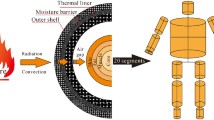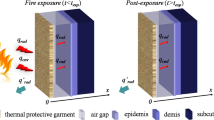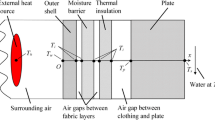Abstract
An accurate and flexible model of heat transfer through firefighter protective clothing has many uses, including investigating the degree of protection, in terms of burn injury and heat stress, of a particular fabric assembly and analyzing cheaply and quickly the expected performance of new or candidate fabric designs or fabric combinations.
This paper presents the first stage in developing a heat transfer model for firefighters' protective clothing. The protective fabrics are assumed to be dry, which means no moisture from perspiration, and the fabric temperatures considered are below the point of thermal degradation, such as melting or charring. Many firefighter burns occur even when there is no thermal degradation of their protective gear. A planar geometry of the fabric layers is assumed with one-dimensional heat transfer. The forward-reverse model is used for radiative heat transfer. The accuracy of the model is tested by comparing time-dependent temperatures from both within and on the surface of a typical fabric assembly to those obtained experimentally. Overall, the model performed well, especially inside the garment where the temperature difference between the experiment and the stimulation was within 5°C. The predicted temperature on the outer shell of the garment differed most from experimental values, by much as 24°C. This was probably due to the absence of fabric-specific optical properties, such as transmissivity and reflectivity, used for model input.
Similar content being viewed by others
References
Torvi, D. A., “Heat Transfer in Thin Fibrous Materials Under High Heat Flux Conditions,” Ph.D. thesis, Mechanical Eng. Dept., University of Alberta, Calgary, Alberta, 1997.
Chen, N.Y., “Transient Heat and Moisture Transfer Through Thermally Irradiated Cloth,” Ph.D. thesis, Massachusetts Institute of Technology, Cambridge, Mass., 1959.
Backer, S., et al., “Textile Fabric Flammability,” The MIT Press, Cambridge, Mass., 1976.
Wulff, W., Zuber, N., et al., “Study of Hazards from Burning Apparel and the Relation of Hazards to Test Methods,” Second Final Report: Georgia Institute of Technology, NTIS: COM-73-10956, 1972.
Morse, H. L., Green, K. A., Thompson, J. G., Moyer, C. B., and Clark, K. J., “Analysis of the Thermal Response of Protective Fabrics,” Technical Report, Acurex Corp., Mountain View, Calif., 1972.
Stoll, A. M., Chianta, M. A., and Munroe, L. R., “Flame-Contact Studies,” Transactions of the ASME, Journal of Heat Transfer, Vol. 86, (1964), pp. 449-456.
Stoll, A. M. and Chianta, M. A., “Burn Protection and Prevention in Convective and Radiant Heat Transfer,” Aerospace Medicine, Vol. 39, 1968, pp. 1097-1100.
Stoll, A.M. and Chianta, M.A. “Method and Rating System for Evaluation of Thermal Protec-tion,” Aerospace Medicine, Vol. 40,No. 11, pp. 1232-1238.
American Society for Testing and Materials, ASTM D 4108-87, Standard Test Method for Thermal Protective Performance of Materials for Clothing By Open-Flame Method, West Conshohocken, Pa., 1987.
Bamford, G. J. and Boydell, W., “ICARUS: A Code for Burn Injury Evaluation,” Fire Technology, Vol. 31,No. 4 (1995), pp. 307-335.
NFPA 1971, Protective Ensemble for Structural Fire Fighting, 1997 edition, National Fire Protection Association, Quincy, Mass.
Krasny, J. F., Rockett, J. A., and Huang, D. “Protecting Fire Fighters Exposed in Foom Fires: Comparison of Results of Bench Scale Test for Thermal Protection and Conditions During Room Flashover,” Fire Technology, Vol. 24,No. 1, (1988), pp. 5-19.
Peacock, R.D., Krasny, J.F., Rockett, J.A. and Huang, D. “Protecting Fire Fighters Exposed in Room Fires, Part 2: Performance of Turnout Coat Materials Under Actual Fire Conditions,” Fire Technology, Vol. 26, 1990, pp. 202-222.
Lawson, J. R., “Fire Fighter's Protective Clothing and Thermal Environments of Structural Fire Fighting,” NISTIR 5804, National Institute of Standards and Technology, Gaithersburg, Md., (1996).
Lawson, J. R., “Development of an Apparatus for Measuring the Thermal Performance of Fire Fighter's Protective Clothing,” NISTIR 6400, National Institute of Standards and Technology, Gaithersburg, Md., (1999).
Özisik, M. N., Radiative Transfer and Interactions with Conduction and Convection, John Wiley & Sons, New York, 1973.
Özisik, M. N., Heat Transfer: A Basic Approach, McGraw-Hill, Inc., New York, 1985.
Comeford, J. J., “The Spectral Distribution of Radiant Energy of a Gas-Fired Radiant Panel and Some Diffusion Flames,” Combustion and Flame, Vol. 18, (1972), pp. 125-132.
Quintiere, J., “Radiative Characteristics of Fire Fighter's Coat Fabrics,” Fire Technology, Vol 10, (1974), pp. 153-161.
Griffith, M. V. and Horton, G. K., “The Transient Flow of Heat Through a Two-Layer Wall,” Proceedings of the Philosophical Society, London, England, Vol. 56 (1946), pp. 481-487.
Wu, Yung-Chi, “Material Properties Criteria for Thermal Safety,” Journal of Materials, Vol. 4 (1972), pp. 573-579.
Minimum Standards on Structural Fire Fighting Protective Clothing and Equipment: A Guide for Fire Service Education and Procurement, Federal Emergency Management Agency, United States Fire Administration, FA-137, September 1993.
Rights and permissions
About this article
Cite this article
Mell, W.E., Lawson, J.R. A Heat Transfer Model for Firefighters' Protective Clothing. Fire Technology 36, 39–68 (2000). https://doi.org/10.1023/A:1015429820426
Issue Date:
DOI: https://doi.org/10.1023/A:1015429820426




